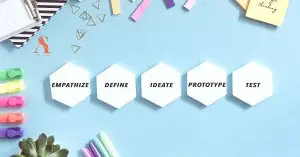Design thinking: Have you ever faced a challenge that you were unable to overcome? To make everybody happy, you might have needed to figure out how to set up everything or choose a food.
Design thinking is a unique way of thinking that uses creativity and empathy to solve issues. Every phase of design thinking will be explained
In this essay, which is simple enough for both novices and children to understand. Let’s examine how you can use this enjoyable method to come up with a novel answer for any issue!
Design thinking: what is it?
In fact, design thinking is a method of issue solving that involves testing on new ideas, thinking like a detective, and focusing on those involved.
Consider yourself a superhero investigator on a quest to learn about people’s needs and desires before devising an original answer that would satisfy everyone.
In order to develop goods, services, or solutions to enhance people’s lives, designers, inventors, as well as large corporations frequently employ design thinking.
But don’t worry, you can begin utilizing design thinking methods immediately; you just do not have to be a mature adult to do so!
What Makes Design Thinking Vital?
Design thinking pushes us to think creatively and improves our understanding of issues.
Design thinking encourages us to experiment and explore new ideas rather than settling on a single answer.
Whether you’re an adult developing an innovative item or a child completing an academic task, this is beneficial to everyone.
Designs Thinking Steps
Typically, design thinking is divided into five main steps. You grow closer to comprehending the issue and identifying the best solution with each stage.
First Step 1: Show empathy
Feelings are an attempt to comprehend the feelings of others on the issue.
Consider yourself a superhero who has the ability to read people’s thoughts! This level is all about hearing attentively & putting yourself in other people’s shoes.
For instance, you would speak with the children regularly and go to the park to find out what they enjoy and dislike if you wanted to make improvements.
Do they desire additional swings? Or even a larger slide? Being empathetic enables you to clearly see what other people need.
second Step 2: Define
Once you grasp how people feel, the next step is to clearly define the problem. Think of this as summarizing the issue in one straightforward sentence.
If your goal is to improve the playground, the problem might be, “Kids don’t have enough fun things to play with.”
By defining the problem, you ensure that everyone understands exactly what you’re aiming to solve, which makes it easier to come up with effective solutions.
Next Step 3: Ideate
Now comes the exciting part: ideating or brainstorming ideas! This is where you let your creativity flow and think of all the possible ways to tackle the problem.
Jot down every idea that comes to mind, even if it seems a bit out there.
For instance, you might consider adding a trampoline, a slide that wraps around a tree, or even a tunnel made of colorful lights.
The goal here is to generate as many ideas as you can before narrowing down to the best one.
Then Step 4: Prototype
In this step, you create a prototype, or a small test version of your idea.
It doesn’t need to be flawless—it’s just a rough draft to see if your concept might work. For example, if you’re looking to design a new playground, you could build a model or sketch a picture of it.
Creating a prototype allows you to identify what works and what doesn’t before investing significant time and effort into the final version.
Finally, Step 5: Test
The final step is to test your prototype and gather feedback from others. Take your model to the playground and share it with the other kids.
Do they enjoy it? What changes would they suggest? Testing helps you determine if your idea effectively addresses the problem or if it requires some tweaks.
